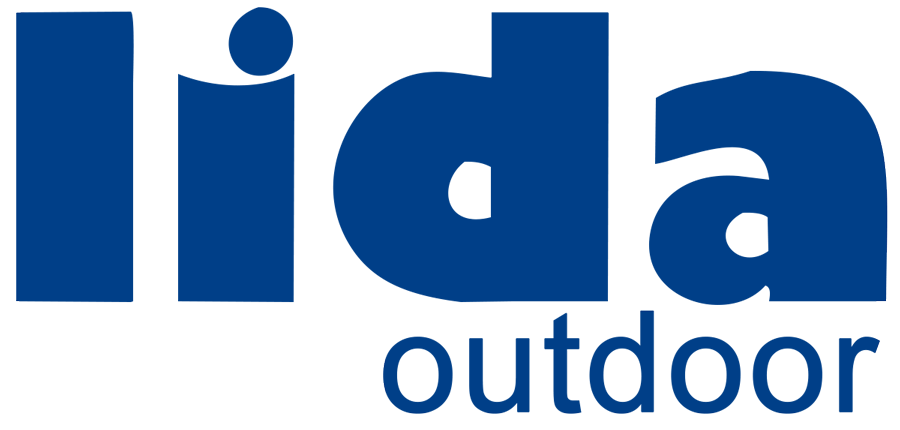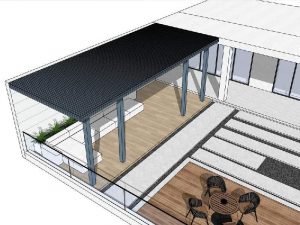When you’re planning to build a patio cover and researching prices online, you might find quotes ranging from $3,000 to $25,000. Why such a wide price gap? The truth is, patio cover costs are influenced by multiple factors, including materials, dimensions, structure type, installation method, and even regional labor costs can significantly impact your budget.
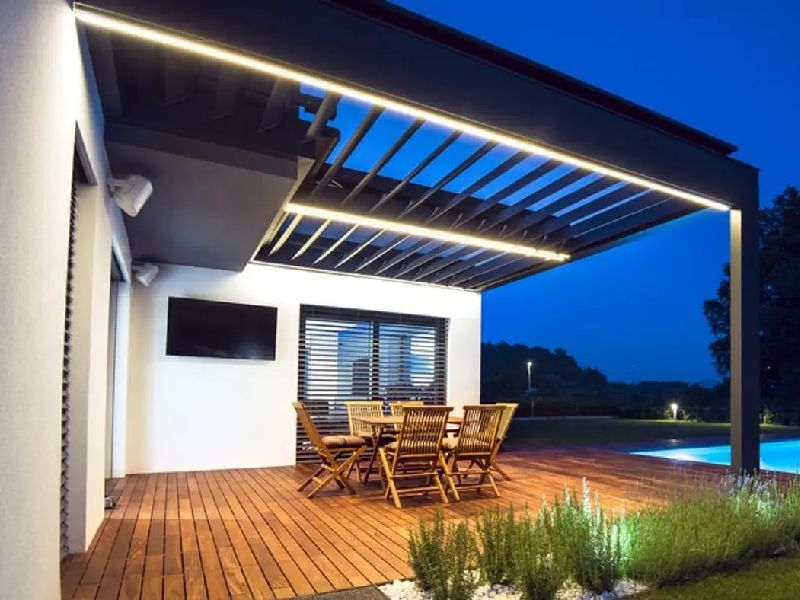
In this article, LIDA OUTDOOR’s expert breaks down the fundamental factors that influence patio cover costs and shares a simple calculator tool to help you quickly estimate the price of your ideal patio cover setup.
Related Reading: Patio Cover Types & Materials Guide
Part 1. 5 Key Factors That Affect Patio Cover Costs
What exactly determines the cost of a patio cover?
To answer this question, we need to deeply understand the various factors that influence patio cover costs. From material selection to structure type, from size to regional differences, every detail can significantly impact the final budget. Next, we’ll systematically break down the main cost-influencing factors of patio covers into five core aspects. To make the content more intuitive and easy to compare, this section will include detailed explanations with multiple tables.
1. Roof Type
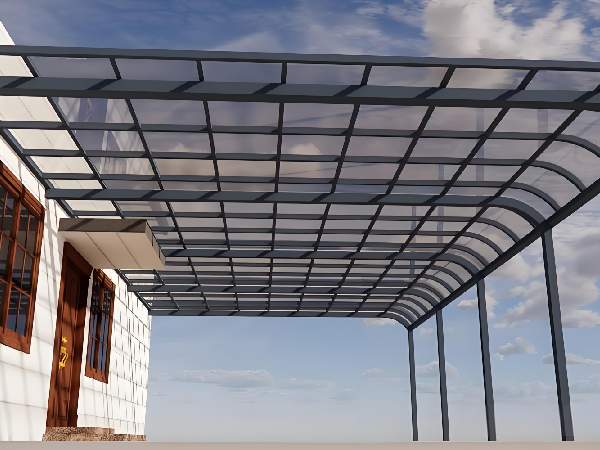
Roof type is the fundamental factor determining patio cover costs. Different roof structures vary significantly in material usage, construction complexity, functionality, and price. Choosing the right roof type is the first step in controlling your budget.
| Roof Type | Advantages | Drawbacks | Suitable For | Price Range (per sq ft) |
|---|---|---|---|---|
| Awnings | Lightweight structure, easy installation, lowest cost, suitable for temporary or seasonal use. | Simple structure, limited shade coverage, not suitable for harsh weather. | Budget-conscious users need a quick installation. | $8-15/sq ft |
| Pergolas | Open design, excellent ventilation, and high aesthetic appeal can be paired with climbing plants. | Doesn’t provide complete shade, requires additional shading materials. | Yards seeking beauty and natural style. | $12-20/sq ft |
| Full Roof Systems | Complete sun and rain protection, stable structure, suitable for long-term use, and highly functional. | Higher cost, requires professional installation, and a drainage system. | Outdoor spaces need all-weather use. | $40-70/sq ft |
| Enclosed Patios | Fully enclosed, can install doors and windows, provides an independent space, and offers the most comprehensive functionality. | The highest cost requires more materials and complex construction. | Projects needing independent space or commercial use. | $60-100/sq ft |
From a cost perspective, awnings and pergolas are suitable for budget-limited users, while complete roof systems and enclosed patios are better suited to projects that prioritize functionality and long-term use.
2. Material
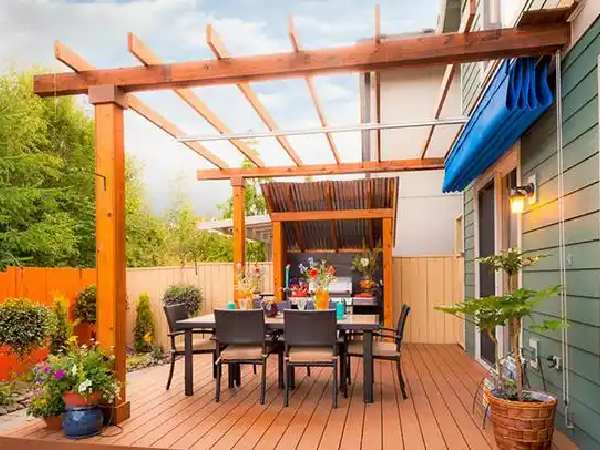
Now that we understand how roof type affects costs, let’s examine another critical factor—material selection. Materials not only determine the appearance and durability of your patio cover but are also one of the most important variables affecting cost. Different materials vary significantly in appearance, durability, maintenance difficulty, and price, which will directly determine your budget.
| Material Type | Features & Advantages | Potential Drawbacks | Suitable For | Price Multiplier (relative to wood) |
|---|---|---|---|---|
| Wood | Natural texture, high customizability, and blends well with the yard environment. | Requires regular painting and anti-corrosion treatment, prone to moisture deformation. | Homeowners focused on aesthetics and style. | 1.0 (baseline) |
| Aluminum | Lightweight, rust-proof, corrosion-resistant, maintenance-free; easy installation, long lifespan. | Fast heat conduction, modern appearance. | Users seeking value and long-term use, or wholesale buyers. | 1.2 |
| Steel | High structural strength, strong wind and pressure resistance, suitable for large-span designs. | Heavyweight, complex installation requires rust prevention maintenance. | Scenarios with strong winds or large-scale projects. | 1.3 |
| Composite | Combines the advantages of multiple materials, strong durability, and low maintenance costs. | Higher cost, relatively limited options. | Users seeking low maintenance and long-term use. | 1.4 |
| Polycarbonate | High light transmission, UV protection, excellent weather resistance, suitable for semi-transparent roof designs. | Slightly higher cost, easily scratched, and high installation requirements. | Users want to maintain natural light and create bright spaces. | 1.1 |
3. Size & Coverage Area
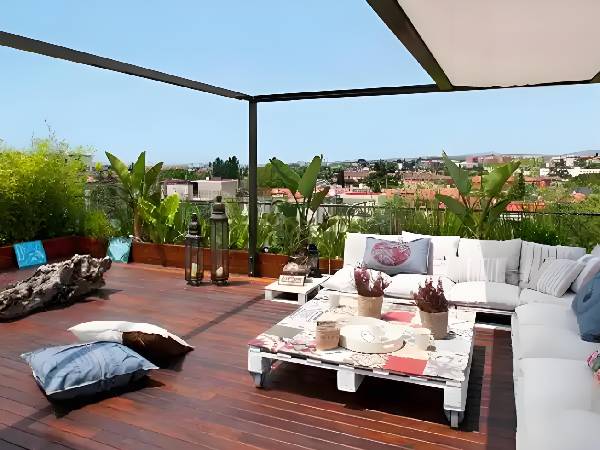
Size not only affects the quantity of material but also affects how unit costs are calculated. While larger areas mean higher total prices, the cost per square foot tends to decrease, at least in part, due to the amortization of fixed costs (such as design, permits, and foundation work).
| Size Category | Features & Advantages | Potential Drawbacks | Suitable For | Cost Trend |
|---|---|---|---|---|
| Small (≤150 ft²) | Less material, faster construction, easier approval, and suitable for space-limited yards. | Fixed costs account for a higher proportion, unit price may be relatively high. | Small family patios, simple leisure areas. | Lower total cost, but higher unit price |
| Medium (150–300 ft²) | Good balance between cost and practicality, can combine shade and decoration. | More design choices, but the total price starts to rise. | Standard family patio cover sizes. | Best value for money |
| Large (≥300 ft²) | Strong sense of space, can accommodate furniture, dining areas, or multi-person leisure areas. | Higher material, foundation, and drainage requirements; a longer installation period. | Large yards, commercial or semi-open space projects. | High total cost, but relatively lower unit cost |
Therefore, from an investment perspective, medium-sized patio covers typically achieve the best balance between “cost” and “user experience.”
Beyond size and materials, there’s another often-overlooked but hugely impactful factor—your geographic location. The same patio cover can cost more than double in different regions.
4. Location & Regional Factors
Even with identical materials and designs, patio cover costs can vary by more than double across different regions. This primarily comes from three aspects: local labor costs, building permit policies, and climate or geographic conditions.
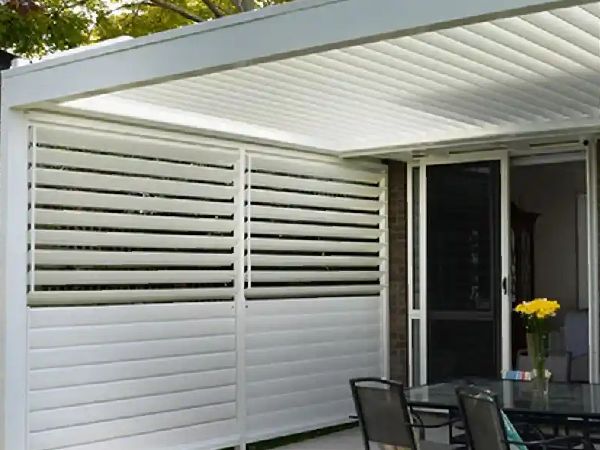
In some regions, building codes require higher wind or snow resistance standards, which can mean thicker support columns, stronger connectors, or more complex foundation structures—all of which drive up costs. On the other hand, labor price differences are equally significant: construction costs in urban areas are typically higher than in suburban areas.
| Region Type | Features & Impact | What You Need to Know | Suitable For | Price Multiplier |
|---|---|---|---|---|
| Rural Areas | Lower labor costs, increased material transportation costs, and relatively lenient building codes. | Understand material delivery costs and local building codes in advance. | Budget-conscious users with large-scale projects. | 0.8 (20% cheaper) |
| Urban Areas | Higher labor costs, but convenient material access, and strict building codes. | Need to apply for permits in advance and understand local building codes. | Most urban users. | 1.0 (baseline) |
| Storm-Prone Areas | Requires reinforced structures, higher material requirements, and may increase labor costs. | Must meet wind resistance standards, may require additional reinforcement. | Storm-prone states like Florida, Texas. | 1.2 (20% more expensive) |
Before starting construction, one thing you absolutely must do is consult with your local government or building department about whether you need to apply for a patio cover construction permit and understand relevant regulations (such as load standards, drainage requirements, structural limitations, etc.). This not only avoids forced shutdowns or fines during construction but also helps you more accurately estimate project timeline and overall costs.
Regional factors affect base costs, while additional features represent investments on top of the foundation. These features will increase your budget but can significantly enhance the practical value and comfort of your patio.
5. Additional Features & Options
Beyond the basic structure, patio covers can include a range of features to enhance the user experience. These additional features will increase costs but can significantly improve the practicality and comfort of your patio.
| Additional Feature | Features & Advantages | Cost Impact | Suitable For |
|---|---|---|---|
| Drainage System (Gutters) | Effectively manages rainwater, prevents water accumulation, and protects patio and surrounding areas. | Base $600 + $15/linear foot | All patio covers require waterproofing. |
| Electrical Installation | Provides lighting and fans, extends usage time, and enhances comfort. | Base $800 + $2/sq ft | Users want nighttime use. |
| Foundation Reinforcement | Enhances structural stability and is suitable for large or freestanding structures. | Base $600 + $200/footing (minimum 4) | Large projects or freestanding structures. |
| Building Permits | Meets local regulatory requirements, avoids legal risks. | Average $800 | Regions and projects requiring permits. |
| Patio Repair | Repairs the existing patio and prepares for installation. | $15/sq ft | Projects where the existing patio needs repair. |
In most cases, selecting only the necessary additional features based on actual needs rather than configuring everything can provide a sufficiently comfortable experience while keeping the budget under control.
Now that you understand the five core factors affecting costs, you might wonder: where do these price data come from? Are they reliable? Let’s look at market reference prices from professional websites.
Part 2. Patio Cover Cost Calculator
In this section, you no longer need to worry about how much you’ll spend. We’ve prepared a simple cost-estimation tool that lets you quickly calculate an approximate budget range based on your patio’s dimensions, materials, and roof type.
Patio Cover Cost Calculator
Material options will update automatically based on your roof type selection
Available options will update automatically based on your roof type selection
Note: The following calculation method is based on publicly available market information and mainstream pricing logic, for budget reference only. Actual prices will vary based on region, labor, climate, and permit policies. Prices include materials and professional installation costs.
Calculation Logic
- Determine Patio Area
Measure your patio length and width (e.g., 10 ft × 20 ft = 200 ft²). - Select Roof Type
- Awnings: $8-15/sq ft
- Pergolas: $12-20/sq ft
- Complete Roof Systems: $40-70/sq ft
- Enclosed Patios: $60-100/sq ft
- Select Primary Material
- Wood: Baseline price (multiplier 1.0)
- Aluminum: Price multiplier 1.2
- Steel: Price multiplier 1.3
- Composite: Price multiplier 1.4
- Polycarbonate: Price multiplier 1.1
- Select Region Type
- Rural Areas: Price multiplier 0.8 (20% cheaper)
- Urban Areas: Price multiplier 1.0 (baseline)
- Storm-Prone Areas: Price multiplier 1.2 (20% more expensive, requires reinforcement)
- Select Additional Features (Optional)
- Drainage System (Gutters): Base $600 + $15/linear foot
- Electrical Installation (Lighting/Fans): Base $800 + $2/sq ft
- Foundation Reinforcement: Base $600 + $200/footing (minimum 4)
- Building Permits: Average $800
- Patio Repair: $15/sq ft
Calculation Formula:
- Base Price = (Roof Type Base Price/sq ft × Material Multiplier × Region Multiplier) × Area
- Total Price = Base Price + Additional Feature Costs
Example:
- Area: 20 ft × 15 ft = 300 sq ft
- Roof Type: Full Roof System ($50/sq ft)
- Material: Aluminum (multiplier 1.2)
- Region: Urban (multiplier 1.0)
- Additional Features: Drainage System + Electrical Installation
Calculation:
- Base Price = ($50 × 1.2 × 1.0) × 300 = $60 × 300 = $18,000
- Drainage System = $600 + (2 × (20+15) × $15) = $600 + $1,050 = $1,650
- Electrical Installation = $800 + (300 × $2) = $800 + $600 = $1,400
- Total Price = $18,000 + $1,650 + $1,400 = $21,050
Price Range: Based on minimum and maximum prices, the final estimate will fall within a reasonable range.
Pre-Construction Tips:
- Before starting, find out if your area requires building permits
- Document your patio’s actual orientation, drainage situation, and foundation condition
- Get quotes from at least two contractors or manufacturers, comparing included and excluded items
- Consider off-season installation (November-February), which may save 5-20% on costs
- Professional contractors should install permanent structures to ensure compliance with building codes
After using the calculator, you may have a clearer understanding of patio cover costs. But before making your final decision, let’s address some common questions whose answers might influence your choice.
Part 3. Frequently Asked Questions (FAQ)
Q1: What is the average cost of a Patio Cover?
A: According to our calculator and market data, the average cost of a patio cover ranges between $14,000 and $31,000, depending on size, material, type, and region. Small awnings may cost only $3,000-$5,000, while large enclosed patios can reach $25,000 or more.
Q2: How much can I save with DIY installation?
A: DIY installation can save 30-50% on labor costs, but note that permanent structures (such as full roof systems and enclosed patios) typically require professional installation to ensure compliance with building codes and safety standards. Simple awnings and pergolas are more suitable for DIY, but full roof systems should be installed by professional contractors.
Q3: Which factors most affect the final price?
A: The three most impactful factors are: 1) Roof type (price differences can reach 5-8 times), 2) Size (directly affects material quantity), 3) Material selection (price multipliers range from 1.0 to 1.4). Regional factors and additional features also significantly impact total price.
Q4: How do I choose the most suitable material?
A: Material selection requires considering multiple factors:
- Limited budget: Choose wood, the best value for money
- Seeking low maintenance: Choose aluminum or composite
- Need high strength: Choose steel, suitable for large spans or storm-prone areas
- Want to maintain natural light: Choose polycarbonate
Q5: Do Patio Cover prices include installation costs?
A: Yes, all prices mentioned in this article include materials and professional installation costs. This is based on U.S. market standard “turnkey” pricing, meaning the total cost from materials to completed installation.
Q6: Do I need to apply for building permits?
A: This depends on your local building codes. Generally, permanent structures (full roof systems, enclosed patios) typically require permits, while temporary awnings may not. It’s recommended to consult your local building department before starting construction to avoid future issues.
A: The key to avoiding hidden costs is advance planning:
- Understand if your area requires building permits and their costs
- Check if your existing patio needs repair
- Confirm if additional foundation reinforcement is needed
- Consider the necessity of drainage systems and electrical installation
- Get multiple quotes and carefully compare included items
Q8: Do installation prices vary by season?
A: Yes, off-season installation (November-February) typically saves 5-20% on costs because contractors are more willing to offer discounts during slow periods. However, weather conditions may affect construction progress.
Q9: How do I determine if a quote is reasonable?
A: Methods to determine if a quote is reasonable:
- Use our calculator to get a baseline price range
- Get at least 3-5 professional quotes for comparison
- Ensure quotes include all items (materials, installation, permits, etc.)
- Be cautious of unusually low quotes, which may hide additional fees or quality issues.
Q10: What cost-saving methods can I use if I have a limited budget?
A: Cost-saving strategies for limited budgets:
- Choose lower-cost roof types (awnings or pergolas)
- Choose cost-effective materials (wood)
- Choose medium size (150-300 sq ft) for the best value
- Implement in phases: build basic structure first, add features later
- Consider off-season installation
- Choose rural areas or regions with lower labor costs (if possible)
Part 4. More Convenient Alternatives from LIDA OUTDOOR
After understanding the standard questions, if you find that traditional patio cover costs exceed expectations, or if you simply want a more flexible and economical solution, there are better alternatives available.
For wholesalers, retailers, and project managers pursuing high flexibility and cost efficiency, choosing quickly installable, easy-to-maintain shading products such as hardtop gazebos is often wiser and more cost-effective than traditional fixed patio covers.

In this regard, LIDA OUTDOOR can offer a range of alternative options. All our products support OEM/ODM customization and batch production, allowing free adjustment of dimensions, structures, materials, and colors to meet project needs, helping you create ideal outdoor spaces that balance aesthetics, practicality, and economy.
Conclusion
In summary, planning a patio cover —from understanding price factors to calculating budgets —is often more complex than we imagine. Materials, design, labor, permits—each factor can affect overall costs. But if you don’t want to invest in high construction costs, or simply want a practical and beautiful outdoor leisure space, LIDA OUTDOOR has prepared more flexible options for you.
